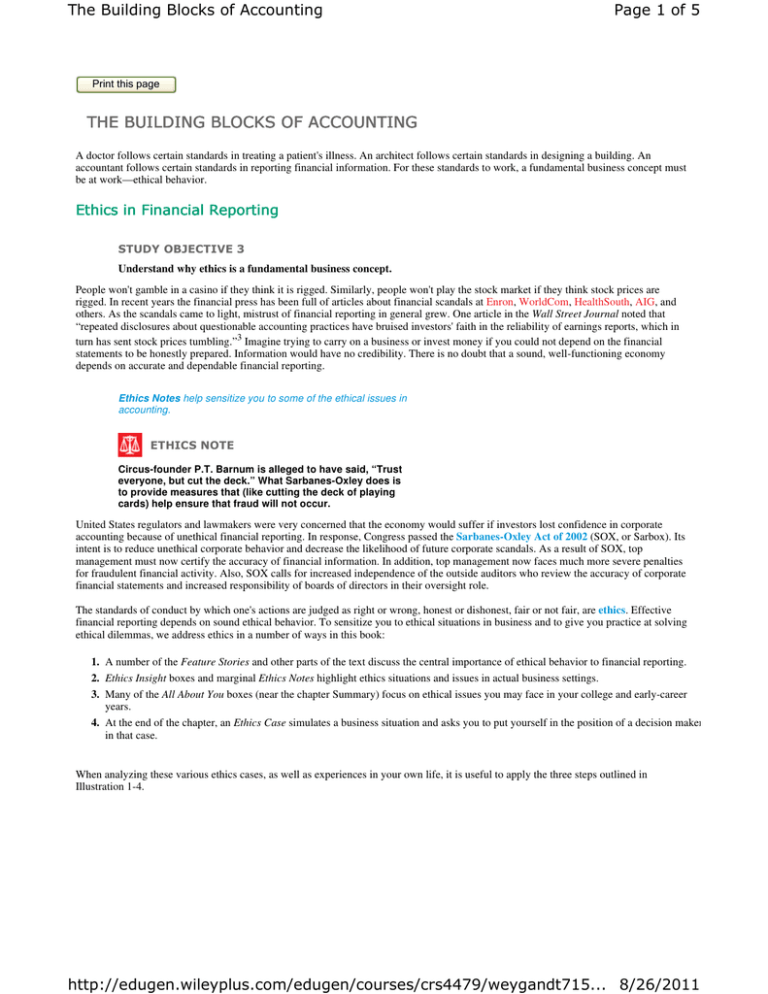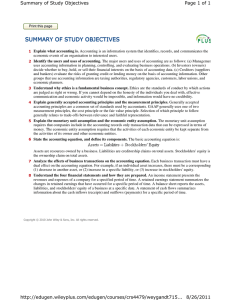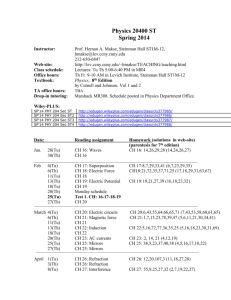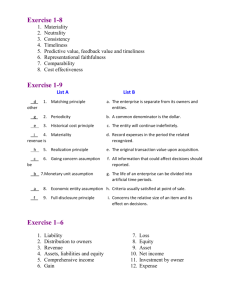
The Building Blocks of Accounting
Page 1 of 5
Print this page
THE BUILDING BLOCKS OF ACCOUNTING
A doctor follows certain standards in treating a patient's illness. An architect follows certain standards in designing a building. An
accountant follows certain standards in reporting financial information. For these standards to work, a fundamental business concept must
be at work—ethical behavior.
Ethics in Financial Reporting
STUDY OBJECTIVE 3
Understand why ethics is a fundamental business concept.
People won't gamble in a casino if they think it is rigged. Similarly, people won't play the stock market if they think stock prices are
rigged. In recent years the financial press has been full of articles about financial scandals at Enron, WorldCom, HealthSouth, AIG, and
others. As the scandals came to light, mistrust of financial reporting in general grew. One article in the Wall Street Journal noted that
“repeated disclosures about questionable accounting practices have bruised investors' faith in the reliability of earnings reports, which in
turn has sent stock prices tumbling.”3 Imagine trying to carry on a business or invest money if you could not depend on the financial
statements to be honestly prepared. Information would have no credibility. There is no doubt that a sound, well-functioning economy
depends on accurate and dependable financial reporting.
Ethics Notes help sensitize you to some of the ethical issues in
accounting.
ETHICS NOTE
Circus-founder P.T. Barnum is alleged to have said, “Trust
everyone, but cut the deck.” What Sarbanes-Oxley does is
to provide measures that (like cutting the deck of playing
cards) help ensure that fraud will not occur.
United States regulators and lawmakers were very concerned that the economy would suffer if investors lost confidence in corporate
accounting because of unethical financial reporting. In response, Congress passed the Sarbanes-Oxley Act of 2002 (SOX, or Sarbox). Its
intent is to reduce unethical corporate behavior and decrease the likelihood of future corporate scandals. As a result of SOX, top
management must now certify the accuracy of financial information. In addition, top management now faces much more severe penalties
for fraudulent financial activity. Also, SOX calls for increased independence of the outside auditors who review the accuracy of corporate
financial statements and increased responsibility of boards of directors in their oversight role.
The standards of conduct by which one's actions are judged as right or wrong, honest or dishonest, fair or not fair, are ethics. Effective
financial reporting depends on sound ethical behavior. To sensitize you to ethical situations in business and to give you practice at solving
ethical dilemmas, we address ethics in a number of ways in this book:
1. A number of the Feature Stories and other parts of the text discuss the central importance of ethical behavior to financial reporting.
2. Ethics Insight boxes and marginal Ethics Notes highlight ethics situations and issues in actual business settings.
3. Many of the All About You boxes (near the chapter Summary) focus on ethical issues you may face in your college and early-career
years.
4. At the end of the chapter, an Ethics Case simulates a business situation and asks you to put yourself in the position of a decision maker
in that case.
When analyzing these various ethics cases, as well as experiences in your own life, it is useful to apply the three steps outlined in
Illustration 1-4.
http://edugen.wileyplus.com/edugen/courses/crs4479/weygandt715... 8/26/2011
The Building Blocks of Accounting
Page 2 of 5
Illustration 1-4 Steps in analyzing ethics cases and situations
Generally Accepted Accounting Principles
STUDY OBJECTIVE 4
Explain generally accepted accounting principles and the
measurement principles.
The accounting profession has developed standards that are generally accepted and universally practiced. This common set of standards is
called generally accepted accounting principles (GAAP). These standards indicate how to report economic events.
Various standard-setting bodies, in consultation with the accounting profession and the business community, determine these guidelines:
The Securities and Exchange Commission (SEC) is the agency of the U.S. government that oversees U.S. financial markets and
accounting standard-setting bodies.
The Public Company Accounting Oversight Board (PCAOB) determines auditing standards and reviews auditing firms.
The Financial Accounting Standards Board (FASB) is the primary accounting standard-setting body in the United States.
The International Accounting Standards Board (IASB) issues international financial reporting standards (IFRS) that have been adopted
by many countries outside of the United States.
INTERNATIONAL NOTE
Over 100 countries use international financial reporting
standards (IFRS). For example, all companies in the
European Union follow international standards. The
differences between U.S. and international standards are
not generally significant. In this book, we highlight any
major differences using International Notes like this one.
We provide an extensive discussion of how IFRS relates to
accounting principles in the IFRS appendix at the end of
the textbook.
International Notes highlight differences between U.S. and
international accounting standards.
The FASB and IASB have worked closely to try to minimize the differences in their standards. Recently the SEC announced that foreign
companies that wish to have their shares traded on U.S. stock exchanges will no longer have to prepare reports that conform with U.S.
accounting standards, as long as their reports conform with international accounting standards. Also, the SEC indicated that it will allow
some U.S. companies to adopt IFRS as early as 2009. The SEC also laid out a roadmap by which all U.S. companies will be required to
switch to IFRS by 2016. The adoption of IFRS by U.S. companies would make it easier for investors to compare U.S. and foreign
companies, as well as for U.S. companies to raise capital in international markets.
MEASUREMENT PRINCIPLES
GAAP generally uses one of two measurement principles, the cost principle or the fair value principle. Selection of which principle to
follow generally relates to trade-offs between relevance and faithful representation. Relevance means that financial information is capable
of making a difference in a decision. Faithful representation means that the numbers and descriptions match what really existed or
happened—it is factual.
http://edugen.wileyplus.com/edugen/courses/crs4479/weygandt715... 8/26/2011
The Building Blocks of Accounting
Page 3 of 5
Cost Principle. The cost principle (or historical cost principle) dictates that companies record assets at their cost. This is true not only
at the time the asset is purchased, but also over the time the asset is held. For example, if Best Buy purchases land for $30,000, the
company initially reports it in its accounting records at $30,000. But what does Best Buy do if, by the end of the next year, the fair value of
the land has increased to $40,000? Under the cost principle it continues to report the land at $30,000.
Fair Value Principle. The fair value principle indicates that assets and liabilities should be reported at fair value (the price received
to sell an asset or settle a liability). Fair value information may be more useful than historical cost for certain types of assets and liabilities.
For example, certain investment securities are reported at fair value because market value information is often readily available for these
types of assets. In choosing between cost and fair value, the FASB uses two qualities that make accounting information useful for decision
making—relevance and faithful representation. In determining which measurement principle to use, the FASB weighs the factual nature of
cost figures versus the relevance of fair value. In general, the FASB indicates that most assets must follow the cost principle because
market values are not representationally faithful. Only in situations where assets are actively traded, such as investment securities, is the
fair value principle applied.
Helpful Hints further clarify concepts being discussed.
HELPFUL HINT
Relevance and faithful representation are two primary
qualities that make accounting information useful for
decision making.
Assumptions
STUDY OBJECTIVE 5
Explain the monetary unit assumption and the economic
entity assumption.
Assumptions provide a foundation for the accounting process. Two main assumptions are the monetary unit assumption and the
economic entity assumption.
MONETARY UNIT ASSUMPTION
The monetary unit assumption requires that companies include in the accounting records only transaction data that can be expressed in
money terms. This assumption enables accounting to quantify (measure) economic events. The monetary unit assumption is vital to
applying the measurement principles.
This assumption prevents the inclusion of some relevant information in the accounting records. For example, the health of a company's
owner, the quality of service, and the morale of employees are not included. The reason: Companies cannot quantify this information in
money terms. Though this information is important, companies record only events that can be measured in money.
ECONOMIC ENTITY ASSUMPTION
ETHICS NOTE
The importance of the economic entity assumption is
illustrated by scandals involving Adelphia. In this case,
senior company employees entered into transactions that
blurred the line between the employees' financial interests
and those of the company. For example, Aldephia
guaranteed over $2 billion of loans to the founding family.
An economic entity can be any organization or unit in society. It may be a company (such as Crocs, Inc.), a governmental unit (the
state of Ohio), a municipality (Seattle), a school district (St. Louis District 48), or a church (Southern Baptist). The economic entity
assumption requires that the activities of the entity be kept separate and distinct from the activities of its owner and all other economic
entities. To illustrate, Sally Rider, owner of Sally's Boutique, must keep her personal living costs separate from the expenses of the
Boutique. Similarly, McDonald's, Coca-Cola, and Cadbury-Schweppes are segregated into separate economic entities for accounting
purposes.
Proprietorship. A business owned by one person is generally a proprietorship. The owner is often the manager/operator of the
business. Small service-type businesses (plumbing companies, beauty salons, and auto repair shops), farms, and small retail stores (antique
shops, clothing stores, and used-book stores) are often proprietorships. Usually only a relatively small amount of money (capital) is
http://edugen.wileyplus.com/edugen/courses/crs4479/weygandt715... 8/26/2011
The Building Blocks of Accounting
Page 4 of 5
necessary to start in business as a proprietorship. The owner (proprietor) receives any profits, suffers any losses, and is personally
liable for all debts of the business. There is no legal distinction between the business as an economic unit and the owner, but the
accounting records of the business activities are kept separate from the personal records and activities of the owner.
Partnership. A business owned by two or more persons associated as partners is a partnership. In most respects a partnership is like
a proprietorship except that more than one owner is involved. Typically a partnership agreement (written or oral) sets forth such terms as
initial investment, duties of each partner, division of net income (or net loss), and settlement to be made upon death or withdrawal of a
partner. Each partner generally has unlimited personal liability for the debts of the partnership. Like a proprietorship, for accounting
purposes the partnership transactions must be kept separate from the personal activities of the partners. Partnerships are often used
to organize retail and service-type businesses, including professional practices (lawyers, doctors, architects, and certified public
accountants).
Corporation. A business organized as a separate legal entity under state corporation law and having ownership divided into
transferable shares of stock is a corporation. The holders of the shares (stockholders) enjoy limited liability; that is, they are not
personally liable for the debts of the corporate entity. Stockholders may transfer all or part of their ownership shares to other
investors at any time (i.e., sell their shares). The ease with which ownership can change adds to the attractiveness of investing in a
corporation. Because ownership can be transferred without dissolving the corporation, the corporation enjoys an unlimited life.
Although the combined number of proprietorships and partnerships in the United States is more than five times the number of
corporations, the revenue produced by corporations is eight times greater. Most of the largest enterprises in the United States—for
example, ExxonMobil, General Motors, Wal-Mart, Citigroup, and Microsoft—are corporations.
The
exercises ask you to put newly acquired
knowledge to work. They outline the Action Plan necessary to
complete the exercise, and they show a Solution.
before you go on...
Basic Concepts
Indicate whether each of the five statements presented below is true or false.
1. The three steps in the accounting process are identification, recording, and communication.
2. The two most common types of external users are investors and company officers.
3. Congress passed the Sarbanes-Oxley Act of 2002 to reduce unethical behavior and decrease the likelihood of future
corporate scandals.
4. The primary accounting standard-setting body in the United States is the Financial Accounting Standards Board
(FASB).
5. The cost principle dictates that companies record assets at their cost. In later periods, however, the fair value of the asset
must be used if fair value is higher than its cost.
Solution
Action Plan
Review the basic concepts learned to date.
Develop an understanding of the key terms used.
1.
2.
3.
4.
5.
True
False. The two most common types of external users are investors and creditors.
True.
True.
False. The cost principle dictates that companies record assets at their cost. Under the cost principle, the company must
also use cost in later periods as well.
Related exercise material: E1-1, E1-2, E1-3, E1-4, and Do it! 1-1.
http://edugen.wileyplus.com/edugen/courses/crs4479/weygandt715... 8/26/2011
The Building Blocks of Accounting
Page 5 of 5
ACCOUNTING ACROSS THE ORGANIZATION
How Will Accounting Help Me?
Brent Holland/iStockphoto.
Accounting Across the Organization boxes
demonstrate applications of accounting information in
various business functions. Guideline answers are
provided on the last page of the chapter.
One question that students frequently ask is, “How will the study of accounting help me?” It should help you a great deal,
because a working knowledge of accounting is desirable for virtually every field of endeavor. Some examples of how accounting
is used in other careers include:
General management: Imagine running Ford Motors, Massachusetts General Hospital, Northern Virginia Community College, a
Subway franchise, a Trek bike shop. All general managers need to understand where the enterprise's cash comes from and
where it goes in order to make wise business decisions.
Marketing: A marketing specialist at a company like Procter & Gamble develops strategies to help the sales force be
successful. But making a sale is meaningless unless it is a profitable sale. Marketing people must be sensitive to costs and
benefits, which accounting helps them quantify and understand.
Finance: Do you want to be a banker for Bank of America, an investment analyst for Goldman Sachs, a stock broker for Merrill
Lynch? These fields rely heavily on accounting. In all of them you will regularly examine and analyze financial statements. In
fact, it is difficult to get a good finance job without two or three courses in accounting.
Real estate: Are you interested in being a real estate broker for Prudential Real Estate? Because a third party—the bank—is
almost always involved in financing a real estate transaction, brokers must understand the numbers involved: Can the buyer
afford to make the payments to the bank? Does the cash flow from an industrial property justify the purchase price? What are
the tax benefits of the purchase?
How might accounting help you?
Answer:
You will need to understand financial reports in any enterprise with which you are associated. Whether you become a
business manager, doctor, lawyer, social worker, teacher, engineer, architect, or entrepreneur, a working knowledge of
accounting is relevant.
Copyright © 2010 John Wiley & Sons, Inc. All rights reserved.
http://edugen.wileyplus.com/edugen/courses/crs4479/weygandt715... 8/26/2011




